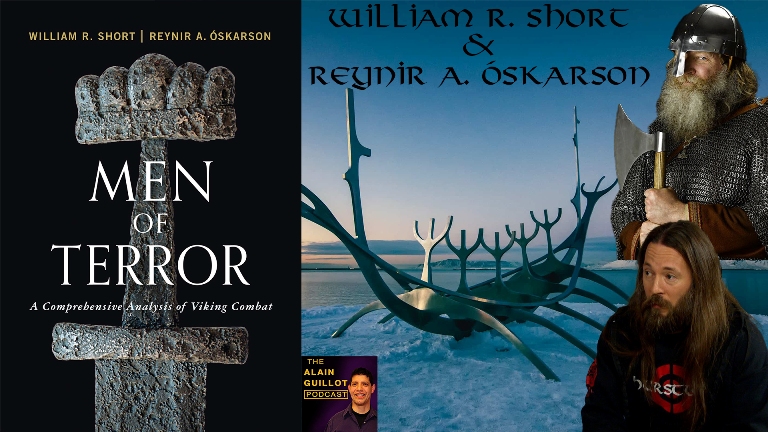Research scientist William R. Short and independent scholar and martial arts instructor Reynir A. Óskarson share with us, not only why the Vikings were such terrifying warriors, but also how they lived their everyday life when they were not fighting.
The Vikings were warriors who terrorized Europe between 700 and 1000. They also explored the coast of Europe and the North Atlantic and even reached America.
The Vikings lived in Scandinavia, the northern part of Europe. They conquered and raided parts of England, France, and Germany, and even got as far south as Spain and Italy.
About William R. Short
Dr. William R. Short is an author, filmmaker, lecturer, and independent scholar specializing in Viking-age topics, notably medieval Icelandic literature, Viking-age material culture, Viking-age weapons, and Viking-age combat techniques.

Dr. Short is the manager of Hurstwic, LLC, an organization that researches, practices, teaches, and demonstrates the fighting moves of Viking-age warriors. This teaching has led to the creation of a series of Viking combat training videos, as well as two feature-length documentary films with accompanying picture books based on historic Viking-age battles from the Sagas of Icelanders.
In the fall of 2019, Dr. Short and Hurstwic co-sponsored a festival of experimental archaeology in Iceland with Eiríksstaðir, the Viking-age home of Eirík the Red. The focus of the festival was uncovering the lost secrets of making iron in Viking-age Iceland, secrets that had been forgotten centuries ago. We brought together teams of experts from North America, Iceland, and Europe in a multi-faceted research project that culminated with our making iron in Iceland for the first time in centuries, using all Icelandic materials and Viking-age tools and techniques.
About Reynir A. Óskarson
REYNIR A. ÓSKARSON, a native of Iceland, is a martial arts instructor and has led much of the combat research at Hurstwic.

His study of glíma, the Viking-age empty-hand combat that evolved into Iceland’s national sport, has been recognized for its importance by Glímusamband Íslands, the wrestling association of Iceland.
Men of Terror: A Comprehensive Analysis of Viking Combat

Sometime near the end of the tenth century, a man named Fraði died in Sweden. His kinsmen raised a granite runestone to his memory in Denmark. The carved message appears to tell us that Fraði was “first among all Vikings” and that he was the “terror of men.”
Known sources about the Vikings revolve around the constant threat of violence: literary and artistic sources from both inside and outside Viking lands, including poetry, myths, stories, and artwork; law codes; burial practices; weapons; even their ship and house architecture.
Based on nearly two decades of research, Men of Terror: A Comprehensive Analysis of Viking Combat is a richly illustrated interdisciplinary study of the heart of Viking society: weapons and combat.
Relying on a vast array of sources from a wide range of fields, research scientist William R. Short and independent scholar and martial arts instructor Reynir A. Óskarson dig deep into the culture of men like Fraði to better understand the mindset and performance of Viking warriors that led them to venerate and praise acts of violence and aggression. In the process they have painstakingly reverse-engineered Viking combat to account for the archaeology we have.
Along the way, they answer questions such as: Were there women warriors? Why were acts such as raiding held in such high esteem? What mundane object was the king of Viking weapons and how was it used? Could bowstrings of human hair really work? Through their comprehensive research, the authors present a holistic picture of this society from what previously had only been disparate and intriguing parts. By the end of the book, the reader will understand the importance of combat to Viking society, the nature of that combat, and the code of these “men of terror.”
